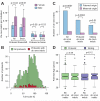De novo insertions and deletions of predominantly paternal origin are associated with autism spectrum disorder
- PMID: 25284784
- PMCID: PMC4194132
- DOI: 10.1016/j.celrep.2014.08.068
De novo insertions and deletions of predominantly paternal origin are associated with autism spectrum disorder
Abstract
Whole-exome sequencing (WES) studies have demonstrated the contribution of de novo loss-of-function single-nucleotide variants (SNVs) to autism spectrum disorder (ASD). However, challenges in the reliable detection of de novo insertions and deletions (indels) have limited inclusion of these variants in prior analyses. By applying a robust indel detection method to WES data from 787 ASD families (2,963 individuals), we demonstrate that de novo frameshift indels contribute to ASD risk (OR = 1.6; 95% CI = 1.0-2.7; p = 0.03), are more common in female probands (p = 0.02), are enriched among genes encoding FMRP targets (p = 6 × 10(-9)), and arise predominantly on the paternal chromosome (p < 0.001). On the basis of mutation rates in probands versus unaffected siblings, we conclude that de novo frameshift indels contribute to risk in approximately 3% of individuals with ASD. Finally, by observing clustering of mutations in unrelated probands, we uncover two ASD-associated genes: KMT2E (MLL5), a chromatin regulator, and RIMS1, a regulator of synaptic vesicle release.
Copyright © 2014 The Authors. Published by Elsevier Inc. All rights reserved.
Figures



References
Publication types
MeSH terms
Substances
Grants and funding
LinkOut - more resources
Full Text Sources
Other Literature Sources

